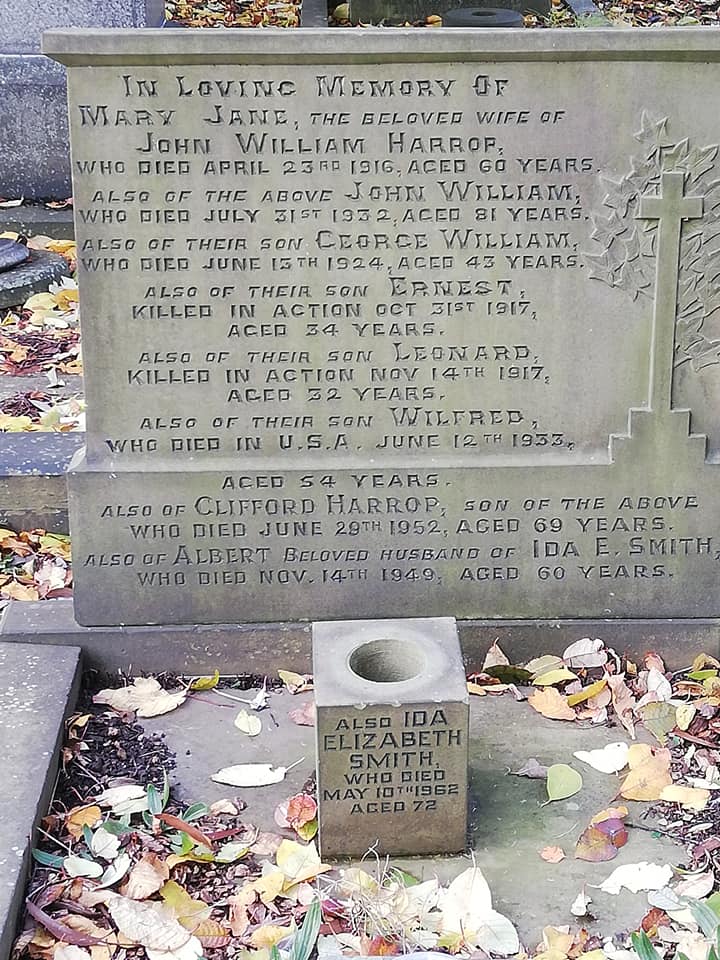
Ernest Harrop was born in Ossett in late 1884, the fifth child of seven born to John William Harrop and his wife, Mary Jane (nee Blacker), who married in 1876. John William was born in Ossett and Mary Jane was born in Horbury. All of the children were born in Ossett.
In 1891 the family were living on High Street, Gawthorpe where John William was a joiner. Their children, including Ernest, were aged between 4 and 13 and were all at school. By 1901 four of the boys, including Ernest, were working with their father as joiners and still living at High Street, Gawthorpe. Ernest’s mother Mary Jane Harrop of High Street Gawthorpe died on the 23rd April 1916.
In September 1909, 24 year old Ernest Harrop, married 30 year old former waiting maid Annie Bradbury and by 1911 the couple have an 18 month-old son, Clifford Gibson Harrop. They were living at 87, Jacob’s Well Lane, Wakefield, but some time later, Annie moved to Orchard Terrace, Wakefield.
Ernest Harrop’s brother Private Leonard Harrop also lost his life in 1917 whilst serving with the 13th Battalion, Manchester Regiment.
211th (Leeds) Field Company, Royal Engineers, served with 31st Division. The units concentrated at South Camp, Ripon in April and May 1915. Training was difficult due to severe shortages of arms, ammunition and equipment. In September they moved to Fovant on Salisbury Plain for final training for service in France. Advance parties had already crossed the channel when the division was ordered to Egypt in December, accompanied by the artillery of 32nd Division in exchange for their own Divisional artillery. They sailed for Egypt in December and took over No 3 Sector of the Suez Canal. They were recalled to France and sailed to Marseilles during the first week of March for service on the Western Front.
Their first action being the attack on Serre in on the 1st of July 1916 during The Battle the Somme. They were also in action during The Battle of the Ancre and in 1917 the Operations on the Ancre before moving north to Arras for The Third Battle of the Scarpe and The Capture of Oppy Wood.
In 1914, each infantry Division included two Field Companies. A third was added during January 1915, as more units came up to strength and passed training. Click here for a list of Field Companies. The Field Company was composed of 217 men. The men were organised into two areas: Mounted (which included the CQMS, the Farrier, the Shoeing Smith, trumpeter, 3 NCOs and the drivers and batmen) and Dismounted. The latter represented many kinds of trades required by the army in the field, including in the numbers shown above 15 blacksmiths, 20 bricklayers, 40 carpenters, 5 clerks, 12 masons, 6 painters, 8 plumbers, plus surveyors, draughtsmen, wheelwrights, engine drivers and others.
The Field Companies relied on horses for transport and had an establishment of 17 riding horses for the officers and NCOs of the Mounted Branch, plus 50 draught heavy horses, and 4 pack horses. There were also five spare draught horses as replacements. With the exceptions of the Trumpeter and Bugler, all other ranks were armed as infantrymen, carrying the SMLE rifle.
There was no specific action ongoing for 31st Division, which Sapper Harrop’s 211th Field Company was attached at the end of October 1917 and the most likely reason for his death on the 31st October 1917 is from being shelled, although this is not known for certain. To date, no details of his death have been found in the archived versions of the “Ossett Observer”.
Ernest Harrop’s army service record has not survived but it is known that he enlisted at Wakefield and was posthumously awarded the British and Victory medals, but not the 1914/15 Star. indicating that he did not serve overseas before the 31st December 1915.
Sapper Ernest Harrop was killed in action on the 31st October 1917, aged 32 years, the husband of Annie Harrop, of 87, Orchard Terrace, Jacob’s Well Lane, Wakefield. He is buried at grave reference II. E. 9. at the Roclincourt Military Cemetery,1 Pas de Calais, France. Roclincourt is a village a little to the east of the road from Arras to Lens.
The French troops who held this front before March 1916 made a military cemetery (now removed), on the south-west side of which the present Commonwealth cemetery was made. It was begun by the 51st (Highland) and 34th Divisions in April 1917, and contains many graves of 9 April, the first day of the Battles of Arras. It continued in use, as a front-line cemetery, until October 1918 and after the Armistice graves, mostly from the battlefield north of Roclincourt, were brought into Plot IV, Row F. Roclincourt Military Cemetery contains 916 Commonwealth burials of the First World War, 32 of them unidentified. There are also four German war graves.
Originally, the cemetery contained a wooden memorial erected by the 22nd Royal Fusiliers to one officer and 27 N.C.O.s and men who fell in action at Oppy in April and May 1917.

Commonwealth War Graves Commission Headstone (Photograph courtesy of local historian, Joan Smith)
References: